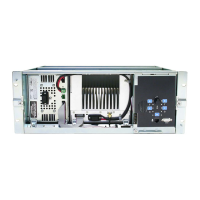TB8100 Service Manual Reciter Circuit Description 29
© Tait Electronics Limited September 2006
2.1 Digital Circuitry
Refer to Figure 2.2 on page 31.
2.1.1 Digital IF
VHF Reciter The heart of the digital IF system is the 14-bit analogue-to-digital converter
(ADC). This is a high-speed device, with a multi-staged “pipeline”
architecture, which is clocked and outputs samples at 40MSPS
(megasamples per second). The analogue IF input of the ADC is a
differential structure, and the output is via a 14-bit parallel bus.
The band-limited 16.9MHz IF signal is sampled by the ADC at 40MSPS.
The sampling process results in images of the input signal appearing at other
frequencies so that the ADC behaves in a similar fashion to a mixer. The
digital output therefore contains the wanted signal and the images, which
can be digitally processed to extract one of the many signals. The desired IF
is at 16.9MHz.
The digital downconverter (DDC) digitally downconverts the 16.9MHz IF
to baseband. This is achieved by digital mixing with a numerically
controlled oscillator (NCO). The mixing process is done using in-phase and
quadrature methods to achieve image rejection, and allows channel filtering
to be applied before the signal is passed to the digital signal processor (DSP)
for demodulation. The digital channel filtering also decimates the sample
rate down to 50kSPS (kilosamples per second) for the DSP.
UHF Reciter The heart of the digital IF system is the 14-bit analogue-to-digital converter
(ADC). This is a high-speed device, with a multi-staged “pipeline”
architecture, which is clocked and outputs samples at 40MSPS
(megasamples per second). The analogue IF input of the ADC is a
differential structure, and the output is via a 14-bit parallel bus.
The band-limited 70.1MHz IF signal is sub-sampled by the ADC at
40MSPS. The sub-sampling results in images of the input signal appearing
at other frequencies so that the ADC behaves in a similar fashion to a mixer.
The digital output therefore contains information in the form of images,
which can be digitally processed to extract one of the many signals. The
lowest frequency image for the 70.1MHz IF and 40MHz clock is at
9.9MHz.
The digital downconverter (DDC) digitally downconverts the desired image
(9.9MHz) to baseband. This is achieved by digital mixing with a
numerically controlled oscillator (NCO). The mixing process is done using
in-phase and quadrature methods to achieve image rejection, and allows
channel filtering to be applied before the signal is passed to the digital signal
processor (DSP) for demodulation. The digital channel filtering also
decimates the sample rate down to 50kSPS (kilosamples per second) for the
DSP.

